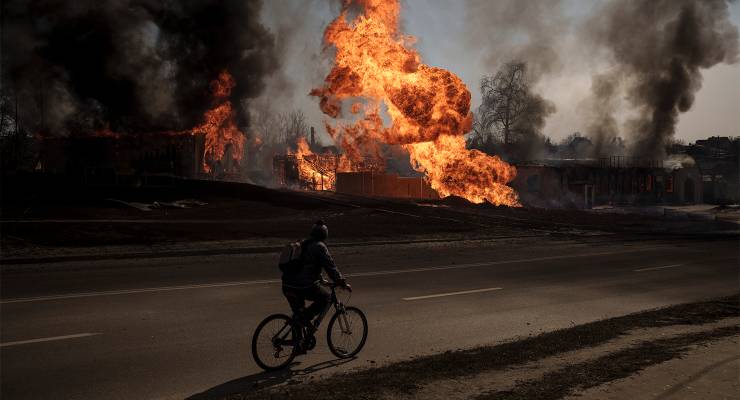
Each month, the scope and scale of Russia’s atrocities in Ukraine expand almost exponentially. There are now millions of refugees, tens of thousands of deaths, and a devastated Ukrainian economy that the World Bank estimates will contract by 45% by the end of the year. Russia’s Dresden-level infrastructure destruction has created a humanitarian crisis in Ukraine, with widespread poverty, misery — and grave long-term human health consequences.
Beneath the human and socioeconomic catastrophe is an evolving array of environmental disasters that will afflict Ukraine’s ecosystems for generations to come.
Environmental damage falls under two broad categories, both of which are relevant in Ukraine: the direct adverse impacts on ecosystems and ecological bioreserves, and the associated human health effects on populations dependent on the services of the environment for the air we breathe, the water we drink, and the food we eat.
The wanton destruction by constant indiscriminate Russian artillery volleys and missiles includes energy infrastructure, oil storage tankers, oil refineries, drilling platforms, gas facilities, gas distribution pipelines, mines, industrial sites, agro-processing facilities, wastewater treatment plants, water supply treatment facilities, pumping stations and other pipelines.
Most prominently, according to UN Environment Program reports, nuclear facilities have been damaged, as well as nuclear waste disposal sites and other sites storing hazardous and toxic chemicals. After each flood and heavy rainfall, these toxic chemicals infiltrate into groundwater and spill over into Ukraine’s waterways. These destroyed sites will become Ukraine’s equivalent to the nearly 1900 toxic Superfund sites scattered around the United States.
Hundreds of industrial facilities, warehouses and factories have also been damaged, some storing a range of hazardous substances ranging from toxic chemical solvents to ammonia and plastics. Hazardous substances have been released from explosions in agro-industrial storage facilities, including fertiliser and nitric acid plants. Billowing clouds of orange noxious fumes could be seen for kilometres after attacks on such chemical plants. These poisonous gases are extremely hazardous to humans and livestock.
War, an anarchic and lawless activity, is nonetheless superficially governed by international conventions, such as the Geneva Conventions, which prohibit drastic and permanent damage to the environment. Under certain circumstances, the International Criminal Court considers such actions war crimes.
For example, during the first Gulf War in 1991, Iraq set fire to hundreds of oil wells in Kuwait and dumped millions of gallons of oil into the Persian Gulf. Kuwait sought reparations from Iraq. Because there were numerous UN Security Council censures on which to build a case, the UN Compensation Commission ordered Iraq to pay nearly $53 billion for the damages it caused, a part of which went for environmental and human health-related damages.
The problem is that international environmental laws are vague and largely unenforceable by the UN system. The International Criminal Court tries individuals for war crimes. Ukraine’s case, which is unable to rely on censures from the Security Council due to Russia’s veto power, would have to go through the UN International Court of Justice. And, in any case, it would be difficult to separate Ukraine’s prior diffuse environmental degradation during the Soviet era from current wartime damages.
Work is underway at the UN to better define a set of legal principles that would guide future prosecution. A division of the UN called the International Law Commission has developed a set of 28 nonbinding principles that clarify how international war laws apply to the environment and the conduct of invading and occupying forces, as well as responsibility for post-conflict reparations and reconstruction.
The recent UN International Law Commission Report on protection of the environment in relation to armed conflicts covered many of the causes of environmental harm during a conflict. A great many directly address Russia’s clear culpability in destroying Ukraine’s infrastructure and its environment.
For example, Draft Principle 17 on protected zones states that “An area of major environmental and cultural importance designated by agreement as a protected zone shall be protected against any attack, as long as it does not contain a military objective.” Russian forces stationed in the Black Sea Biosphere Reserve, along the southern coast near Kherson, caused fires that could be seen from space.
Documentation of such war crimes is essential. To that end, on April 21, Ukrainian President Volodymyr Zelenskyy established a National Council for the Recovery of Ukraine from the War. A working subgroup on environmental security has been formed within the council and is headed by Minister of the Environment Ruslan Strilets. As a first step, the environmental security group is recording all cases of environmental crimes by the occupying Russian forces, aiming to seek future compensation for damages in international courts.
When Russia invaded the Donbas region in 2014, it included the provinces of Donetsk and Luhansk, which are at the center of Ukraine’s coal-mining and industrial region. At that time, the separatist administration shut down and abandoned many coal mines. As a consequence, many mines were flooded through normal rainfall, and rising groundwater levels resulted in overflows of acidic mine waters into the receiving rivers.
Acid mine drainage is one of mining’s most serious threats to aquatic ecosystems. Without continuous pumping and treatment of mine drainage waters, the acidic waters can devastate rivers, streams and aquatic life for more than a generation.
Destroyed wastewater treatment plants are spewing raw sewage into Ukraine’s rivers, and the Russian devastation of Mariupol, centered on the Azovstal steel plant, poses a grave threat to the nearshore coastal ecosystems of the Sea of Azov. The siege of Mariupol began on March 2 and ended May 20, when the remaining Ukrainian forces at Azovstal surrendered. During that time, the Azovstal plant was bombarded mercilessly, destroying all the ground-level infrastructure, along with chemical storage facilities and waste disposal sites. Toxic chemicals have leaked from those sites into the groundwater and the Sea of Azov.
Wastes from iron ore processing and smelting generate a broad array of toxic chemicals and waste byproducts called slag. Under the best of circumstances, the treatment, disposal and storage of such waste impose a wide spectrum of environmental hazards and human health risks, if not managed properly. Neglected and unmanaged toxic waste disposal areas that have been collaterally or intentionally damaged by heavy shelling greatly amplify those ecological risks.
On May 18, the Mariupol City Council said that a leak from a waste storage facility at the Azovstal plant could result in thousands of tons of concentrated hydrogen sulfide solution ending up in the surrounding waters, potentially causing an ecological catastrophe in the Sea of Azov. The slag and waste storage site sits precariously at the very edge of the sea. The site is enclosed by retaining walls, called berms, that have been weakened by the constant proximate monthslong Russian bombardment and require repair.
When the invasion of Ukraine began on February 24, Azovstal took measures to reduce the potential environmental damage in the event of being hit. Coke oven batteries and blast furnaces were shut down, no longer posing a danger to the residents — though most fled the ensuing bombardment.
But while Ukrainians are doing what they can to curb the damage to environmental infrastructure, Russians will use all means of propaganda and misinformation to deny and deflect attention from their own culpability in these environmental war crimes. Russian propaganda is high-volume, rapid, repetitive, and continuous.
A recent Rand National Defense Research Institute study calls it “the firehose of falsehood” because of two of its distinctive features: high numbers of channels and messages, and a shameless willingness to disseminate partial truths or outright fictions.
A little-known but catastrophic event occurred on August 18 1941, when the Dnipro hydroelectric power station, located near the Ukrainian city of Zaporizhzhia, was destroyed by the Red Army as it retreated eastward before the advancing German army.
It is estimated that the resulting flood surge from the dam killed as many as 100,000 unsuspecting civilians downstream, who were given no warning to evacuate. The destruction of that dam was one of the war crimes listed at the Nuremberg trial, implicating Germans, although the Soviets were actually to blame. The world cannot allow such blatant falsifications to smear Ukraine when it comes to accounting for Russia’s war crimes.









Another Crikey piece that looks like it comes directly from the Ukrainian propaganda ministry. Anyone that quotes Zelensky or any Ukrainian source with a straight face, should be treated with skepticism. The CIA has stated that this in an information war. We are expected to believe that the only lies comes from Russia. Even Corey Bernardi has called out Zelensky and Noam Chomsky has said that the lockout of contesting information in the West, now exceeds the Soviet era. Again I suggest you read a Chris Hedges, Mary Kostakidis, Tony Kevin or even Peter Hedges for some truth telling? Bah Crikey! Damn it’s too late to cancel my subscription!
We’ll see what the War Crimes Tribunal come up with.
Would that be the ICC, the one at Den Haag which the US refuses to recognise as having jurisdiction over its actions?
And which has just de-prioritised its investigation into alleged Australian war crimes in Afghanistan.
There is a melanin requirement for investigation or prosecution – unless one is Slav and thus automatically guilty.
Yes, the one whose prosecutors were threatened with sanctions by Trump when they started to look at the USA.
Bush the Lesser wanted to put forward soi disant (so called) ‘Invade the Hague’ legislation during the War on Terror if there was any hint of investigating US actions. Orange jumpsuits for interantional judges would have been popular during the Mission Accomplished hubris hysteria.
So you are not denying that the Russians are lying.
Who is invading who?
Corey Bernadi calling out anyone is a joke. Bernadi has never admitted that Trump lost. Besides, Zelensky is a jew. Enough reason for a psychopath like Bernadi to start sharpening his knives.
Ahhh Stephen don’t be like that. We all know what the article is. Could have even been written before the hostilities started and fill in the locations later. It was an obvious unavoidable outcome of war. So cancelling your Crikey membership is a bit petulant.
Pity Lawson does not run a betting shop as I would have a few bob on anything effectual coming out of a War Crimes Tribunal. A non article.
‘An obvious unavoidable outcome of war’ only for wars that ‘they’ start. Our (many) wars don’t kill civilians, create refugees, damage infrastructure or the environment.
I have been surprised at how little coverage there has been of this, perhaps it’s just too depressing. I try to keep my doomer inclinations at bay, but when this war started and after the first few days seemed likely to go down the Grozny route I did find myself thinking that we have increasingly desperate warnings from the worlds scientists on multiple ecological fronts, with maybe 10 critical years to change course, and what do we get? War in Europe, neofacist War on women in the US, UK war on itself, Australian state capture by the fossil fuel industry.
Its dispiriting.
Back in the day, there used to be a poster “War is not good for children or other living things.”
Too right.